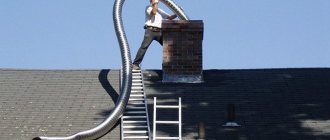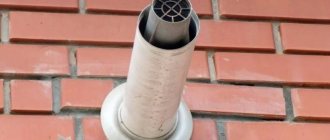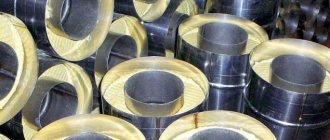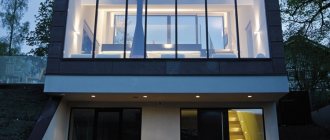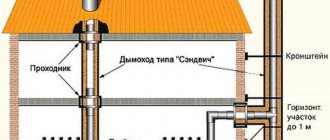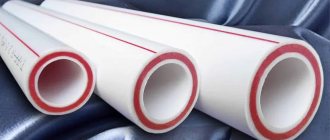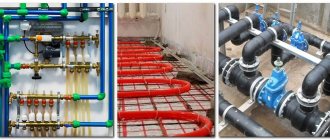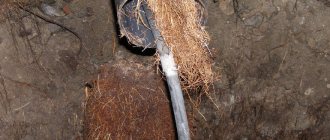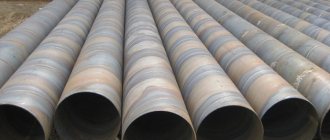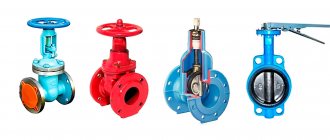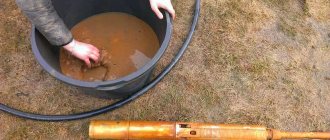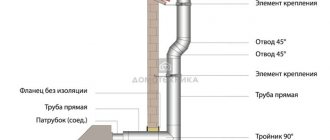Here you will learn:
- Ceramic chimney device
- Why ceramics are better than bricks
- Advantages and disadvantages of ceramic chimneys
- Rules for choosing chimney parameters
- Step-by-step instructions for installing a ceramic chimney
- Helpful installation tips
- Ceramic pipe maintenance
Chimneys made of ceramics have found their field of application, which requires not only resistance to high temperatures, but also anti-corrosion resistance to chemicals. So, the main areas of use for:
- Kaminov.
- Furnaces.
- Boilers (coal, wood, gas).
- Liquid fuel boilers.
In addition to pipes that are designed to exhaust gases with temperatures above 300 degrees, there is also a separate group of channels where the maximum temperature does not exceed 200. These are the so-called low-temperature boilers, where the installation of ceramics is allowed with a temperature threshold of no more than 200 degrees.
Ceramic chimney after installation is completed
Ceramic chimney device
A ceramic chimney, as already mentioned, is a composite structure that includes:
- chimney duct made of ceramics;
- insulation layer or air gap;
- outer layer of expanded clay concrete.
Such a serious design is explained by a number of factors. Firstly, the ceramic pipe that forms the chimney channel is very fragile and needs support. Secondly, it has high thermal conductivity, which is why it requires reliable thermal insulation.
The pipe itself is made of a circular cross-section, ranging from 30 cm to 1 m in length. Its internal walls are smooth, while the external walls may have roughness and minor defects that do not affect the integrity of the structure. The pipes are connected by means of a lock, which is a thinning of the outer diameter at one end and an expansion of the inner diameter at the other. It is extremely important that they dock strictly along one central axis.
The outer shell is made of expanded clay concrete in the shape of a square with a radial cavity inside. The height of the block depends on the manufacturer, as does the shape of the internal cavity. It is also provided for either direct contact of the separate parts of the block with the pipe, or the presence of space for insulation, which is connected by means of metal jumpers. They are attached to the outer shell and create reliable support for the ceramic pipe.
In expanded clay concrete blocks, a prerequisite is the presence of a special hole for laying reinforcement, which allows for maximum strength and stability of the entire structure, which is especially important in the lower and upper parts of the chimney.
For insulation, you can use a layer of basalt wool or an air gap. The latter is used in chimneys with reverse air supply into an insulated combustion chamber or in chimney systems with a maximum temperature of up to +450°C. If the temperature exceeds this figure or it is necessary to provide better thermal insulation, use basalt wool, which is sold in the form of dense pressed slabs, along which grooves are made so that they can be rolled up.
The insulation should be placed tightly between the ceramic pipe and the expanded clay concrete block. The result is a high-strength composite material with low thermal conductivity and perfectly smooth heat-resistant channel walls.
Distances to flammable building structures
The prescribed distance between the chimney and flammable parts of the building, which prevents a fire in the event of overheating or fire inside the chimney, is regulated by the chimney's belonging to a certain fire resistance class. Fire-resistant multi-layer chimneys with an internal ceramic pipe usually belong to class G50, i.e. the required distance to flammable building structures is 50 mm.
In places where the chimney is extensively and not only on individual surfaces adjacent to parts of the building made of flammable materials, the required distance to these structures should be taken into account, which is at least 5 cm; the space between such elements must be constantly open or well ventilated. In exceptional cases, insulation using non-flammable materials is allowed.
Beam ceilings, attic floor beams and similar structures, parts of the building made of flammable materials with a small area of contact with the chimney must also be located at a distance of at least 5 cm from the structure of the chimney itself (it is acceptable to use insulation made of non-combustible materials 2 cm thick).
For flammable materials with a fairly small area of contact with the chimney, such as flooring, baseboards and roof sheathing, it is not necessary to take into account the distance. The chimney should be located no closer than 20 cm from the windows.
The distance from the outer surface of the chimney to other flammable elements of the building is regulated by law. In most countries, including Russia, this distance should be at least 50 mm. This space must be kept open or sufficiently ventilated (Fig. A - C). In some exceptional cases, it is permissible to fill it with non-flammable insulating material.
System elements located outside the main chimney structure
must be at a distance of at least 20 cm from parts of the building made of or containing flammable materials. The exceptions are:
- this element of the system is sheathed with thick non-flammable insulation, at least 2 cm thick, or
- the temperature of the exhaust gases of the heating device does not exceed 160 C°.
Why ceramics are better than bricks
For centuries, the chimney was built from bricks plastered with clay mortar. Why have ceramic pipes become so popular in recent years? The answer is simple: in terms of its characteristics, a ceramic chimney pipe is significantly superior to brick. A ceramic chimney has the following advantages:
- Good traction. Unlike brick, which has a rough surface, ceramic pipes are coated with a heat-resistant glaze on the inside. The smooth surface promotes better draft, so owners of stoves with a ceramic chimney do not have problems with smoke in the house when burning.
- Strength. The glaze has low water permeability, so the pipe does not absorb water, and all condensate, as well as moisture from precipitation, flows into a specially designed sump. Traditional brick pipes, when moisture settles on the porous surface of the brick, absorb it, which at low outside temperatures leads to freezing of water and cracking of brick and mortar.
- Resistance to soot formation. On a smooth surface, soot practically does not settle, and most of it flies into the atmosphere along with smoke. On a brick, soot formation occurs much faster, while the clearance decreases and there is a possibility of it catching fire, which threatens a fire. Even if soot settles on ceramic pipes, it can be easily cleaned using mechanical or chemical methods.
- Fire safety. The ignition of soot in a ceramic pipe is unlikely, but even if this happens, a fire will not occur - the inner coating of the pipe has the necessary heat resistance for this, and its outer walls practically do not heat up due to low thermal conductivity.
- Resistance to chemically aggressive substances. Smoke contains sulfur and nitrogen compounds, which, when interacting with water - condensate or precipitation - form acids. It is because of them that brick and metal chimneys are destroyed. Glazed ceramics do not have this drawback - they do not interact with acids.
- Easy to install. To build a brick chimney with your own hands, you need knowledge, experience and time. Anyone can install a ceramic pipe; just read the instructions carefully. Ceramics are easy to process, can be cut, drilled, polished, and can be installed using conventional tools within one to two days.
Ceramic pipes are not without mandatory requirements that complicate their installation - they are quite heavy compared to stainless steel pipes and the need for a foundation. However, if we take into account their warranty period of 30 to 40 years, this feature is insignificant.
Production Features
The clay raw materials are cleaned, ground into powder and dried.
Fireclay and other fillers are added, combined with water and mixed until plastic.
Next, the mass is extruded on an extruder and cylindrical hollow products are obtained.
They are cut into pieces with a metal string and dried.
Then the blanks are coated with glaze and fired at a temperature of 1250-1300 for about 100 hours.
The result is a stone pipe.
Advantages and disadvantages of ceramic chimneys
Ceramic sandwich chimneys attract consumers with their ability to remove combustion products of various temperatures from 200° C to 1000° C. They are suitable for solid and liquid fuel boilers and have other positive properties:
- fire safety;
- resistance to aggressive environments;
- gas and waterproof;
- sufficient strength;
- resistance to temperature changes and humidity;
- machinability;
- manufacturability.
In general, ceramic chimneys are universal. But they cannot be called ideal due to their massiveness. Therefore, we have to build a foundation, which increases financial costs.
And yet, ceramics and chimneys made from it remain the best. This is due not only to their aesthetics and design. The superiority here is obvious. The secret is environmental friendliness, safety and long service life of the system.
Where is this chimney used?
Ceramics is a fairly high-quality material for a chimney, so it can be used for the following types of boilers:
Temperature difference during normal operation of chimneys
- solid fuel - firewood, coal, coke, pallets;
- for fireplaces and stoves;
- liquid fuel;
- for gas boilers.
When choosing a ceramic chimney pipe, you need to pay attention to the temperature conditions in which it can operate. There are models that are designed for heating systems with low-temperature boilers, where the temperature of combustion products is less than 200°C.
Rules for choosing chimney parameters
The ceramic chimney pipe is made of separate blocks, which fit well together, so there are no smoke leaks. Its height is calculated in advance, in accordance with current regulations. Excessive length of the chimney will not improve draft, but will only create complex aerodynamic vortices that do not contribute to the effective operation of the gas exhaust system. The pipe is assembled according to the following rules:
- height above flat roof 50 cm;
- a pipe located 1.5 m from the ridge must rise 50 cm above it;
- at a distance of up to three meters, the edge of the chimney cannot be below the ridge line;
- being more than 3 m from the ridge, the pipe must reach the axis 10 degrees from its horizon line;
- the diameter of the internal ceramic channel cannot be less than that of the smoke exhaust pipe;
- the height of the pipe from the grate line to the outer edge is not less than five meters.
A ceramic chimney can be used to remove gases from several devices, but in any configuration, the lower module helps to collect condensate. Chimney elements are selected based on the type of heating device: fireplace, boiler or stove. The size of the pipe diameter is affected by the boiler power and the type of fuel. To calculate the required length of a ceramic chimney, you will need the roof height and ceiling value.
Frequent errors and problems during installation
A very serious mistake is the absence of a deflector or at least a cap over the chimney. Snow and rain should not get inside the pipe.
If the chimney goes out onto the roof very close to the ventilation pipes or runs in the same block with them (there is such a modification - both the chimney and the ventilation pipe run in the same building), then the chimney should be higher than the ventilation pipe, preferably by 500 mm.
In places where structures pass through floors, it is prohibited to install joints of individual elements.
Step-by-step instructions for installing a ceramic chimney
Draw up a preliminary work plan, decide on the exact locations of the boiler pipe entry, installation of inspections, dampers, etc. Prepare the foundation for the structure, keep in mind that the weight of the chimney, depending on the manufacturer and height, can exceed 800 kg. Although the dimensions of the blocks are only 40x40 cm, this is a very large load per unit area. The base must be installed taking into account these points, and strictly comply with the requirements of building codes and regulations. Check the completeness of the components, make exits to the attic and roof. Prepare construction and measuring tools.
Chimney height in a private house
Important. The chimney should be installed for at least two days. Not because the work is complicated and time-consuming, but because it is necessary to give time for part of the solution to harden - the lower blocks must be securely fixed. Otherwise, there is a possibility of distortions, and this is a very unpleasant situation.
Installation of the lower part of the chimney
Step 1. Make a mortar to join the concrete blocks. You should use special adhesive compositions for ceramic tiles; ordinary cement-sand mortar is not recommended, since its strength and adhesion indicators do not satisfy the requirements of manufacturers of ceramic chimneys.
You don’t need a lot of solution; it is recommended to prepare no more than half a bucket. First, the required amount of water according to the instructions is poured into it, and then the dry component is added. It is easier to mix with a special mixer; it is sold in construction stores and is used together with ordinary hand drills.
The solution is prepared in small portions
Step 2. Lay out the solution in a continuous layer on the base, but before that you need to mark the dimensions of the blocks. Lay waterproofing on it; for these purposes it is better to use traditional roofing felt; level the base. Remember that the stability of the chimney largely depends on this. It is possible to correct minor deviations from the vertical during further laying of blocks, but an experienced builder will notice the difference in the thickness of the seams.
At the location where the chimney is installed, apply a layer of mortar and lay down roofing material cut to size
Step 3. Using a grinder and a diamond-coated disk, cut a hole in the first block for the condensate drain pipe. Customize a standard ceramic pipe to your individual dimensions. Measure the height and cut off the excess. You should also work with a grinder with a diamond blade.
Holes are cut in the first block with a grinder
Step 4. Apply a uniform layer of glue to the first block and install it on the previously prepared base. Using a level, check the position of the planes in at least two directions. If necessary, lightly tap to adjust the blocks.
Place the block and check the location by level
Step 5: Replace the condensate collector. Check that its plane is strictly horizontal.
A condensate collector is installed inside the unit
Practical advice. There is no need to hope that ceramic blocks will automatically correct the position of ceramic pipes and control only their laying. Experienced craftsmen always check every element of the chimney structure; only this technology guarantees high-quality work on assembling a ceramic chimney.
Step 6. Pre-cut a hole in the block for the inspection door. Spread the solution around the perimeter of the edge and place the second block in place. Check its position using a water level.
Mount the second block with a cut hole
Step 7. Apply sealant around the perimeter of the condensate collector; it is sold complete with the chimney; it is not afraid of high temperatures and exposure to aggressive chemical compounds. Wrap the revision tee with insulation and insert it. To prevent the condensate drain hole from becoming clogged with fallen glue, temporarily cover it with a piece of special stone. Upon completion of installation work, it is removed and the drain hole is opened.
Apply sealant, attach a tee with insulation on top
Install the next block with the prepared hole. Next, install blocks and ceramic pipes until the structure reaches the height of the boiler chimney connection. Constantly check the spatial position of each block, do not forget to lubricate the joints of ceramic pipes with sealant, and put heat protection on them.
Install the remaining blocks in the same way.
Installing a tee under a pipe
The tee under the pipe is mounted as follows.
Step 1. Use a grinder to cut a hole in the blocks for the flange. Its dimensions are the same as for the revision. Cut carefully, do not allow the blocks to crack. If a crack appears, the element will have to be thrown away and replaced with a new one.
Carefully cut a hole in the block for the flange
Step 2. Place the block on the glue and install the consumer connection tee. Apply a layer of mortar and place the next concrete block.
Install the tee and close it with the next block
Then only straight ceramic pipes and whole blocks are used. Work must be continued until the chimney reaches the roof. If you plan to install a gate, you should first make a small hole in the block.
Blocks and parts of the pipe are installed before reaching the roof
Important. The damper is installed only on solid fuel boilers; installation of these devices on gas boilers is strictly prohibited.
Installation of the final part of the ceramic chimney
The final part is the installation of elements located above the roof slope. They have an imitation of natural ceramic brick. The height of the chimney above the roof depends on the distance to the ridge; the parameters are regulated by building codes and regulations.
Rules for installing a ceramic chimney
Step 1. Lay blocks on the solution, then ceramic pipes with insulation using the technology described above. The height of one final block is 7.5 cm. This is explained by the fact that the blocks imitate brick with these dimensions.
Blocks imitating brickwork are installed on the roof
Step 2. Install a metal sheet with a through hole on the last block. It is attached with glue.
At the top of the chimney, a metal sheet with a hole is attached with glue
Step 3. Press the metal sheet with the cover plate and check its position.
After leveling the sheet, install the cover plate
Step 4. Insert metal pins into the special technological holes; the chimney umbrella will be screwed to them in the future.
Studs are inserted into the holes on the plate
Step 5. Place the final piece of ceramic pipe and fit the cone tightly onto it.
The final step is installing the cone on the pipe
The chimney is installed, you can seal the penetration in the roof and seal the exit point. For these purposes, it is recommended to use soft bitumen-based sealants. Pay attention to the quality and installation technology of the seals; leaks often appear at the junction points.
After installing the pipe, all joints must be carefully sealed.
Helpful installation tips
One of the main rules for installing ceramic chimneys: only whole elements are suitable for installation. The presence of chips, cracks or any other damage is unacceptable. You should not try to repair the damaged area with sealant or anything similar.
This is a dangerous solution, since damage hidden inside the structure can fail at any time and cause a fire.
Therefore, each element must be checked at the time of purchase, as well as immediately before installation. If even minor damage is found, a replacement should be made. The base for the adapter must be perfectly flat and horizontal.
To achieve this, experienced builders use a level, and the surface of the base is finished with some smooth material, for example, tiles, porcelain stoneware, etc.
Maintenance of a ceramic chimney must be performed regularly twice a year: inspect, clean from soot and check the draft level
Maintenance of chimneys of this type is not difficult. It is necessary to check the presence of draft, clean the pipes of soot, and monitor the integrity of all structural elements.
Typically, these operations are performed twice a year, but if there is reason to doubt the normal functioning of the chimney, maintenance activities can be performed unscheduled. Although, if installed correctly, problems practically do not arise with such structures.
How to properly secure the pipeline to remove combustion products?
It is best to fasten the pipeline using steel rods with a diameter of at least 10 mm. This can also be done using a ready-made reinforcement system provided by the manufacturer. It must be installed in existing holes in concrete blocks, and then fixed with freshly prepared cement laitance.
Installation of a ceramic chimney
The outer pipe can be strengthened using a reliable metal corset made of corners and tape. It is also possible to carry out additional concreting with reinforcement of the entire ventilation duct, starting from the base.
Ceramic pipe maintenance
Thanks to the features of ceramic pipes, their maintenance is significantly simplified compared to brick ones. Once a year it is necessary to clean them of soot mechanically or using special means. Twice a year all joints are checked for cracks, chips, deformations and distortions. With each fire, it is necessary to evaluate the draft, and if it is violated, look for and eliminate the cause. You also need to monitor the cleanliness of the ventilation duct of sandwich chimneys and drain excess condensate in a timely manner.
A ceramic chimney pipe is a reliable and technologically advanced way to remove combustion products from stoves and any boilers. Installing such a chimney will not be cheap, but the long service life and excellent safety indicators will more than justify your investment.
Scope of application
The area of use of ceramic sewer pipes is not limited to drainage. They are used to install high-quality and safe chimneys, build vertical wells for water intake, and horizontal tunnels.
Drainage ceramic pipes
For the installation of drainage systems, special ceramic pipe products are produced, which can be easily distinguished from sewer products by appearance. Drainage pipes are not glazed; they are matte, often perforated, without sockets. The external design of the products is characteristic - they are not necessarily cylindrical, but can have a hexagonal or octagonal shape. Thickened ribs add strength to the pipeline.
We recommend that you read: Sealants for durable connections of sewer pipes
